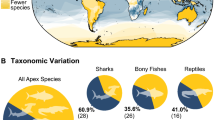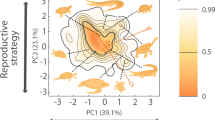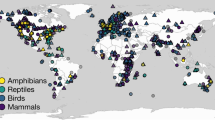Abstract
As both a flagship and umbrella species, the giant panda (Ailuropoda melanoleuca) is one of the most heavily invested species in conservation. Here, we report the wide distribution range retreat of the leopard (Panthera pardus, 81% loss), snow leopard (P. uncia, 38%), wolf (Canis lupus, 77%) and dhole (Cuon alpinus, 95%) from protected areas in the giant panda distribution range since the 1960s. The present findings indicate the insufficiency of giant panda conservation for protecting these large carnivore species and suggest that future conservation efforts should target restoring ecosystems with high trophic complexity to facilitate the recovery of large carnivore populations.
This is a preview of subscription content, access via your institution
Access options
Access Nature and 54 other Nature Portfolio journals
Get Nature+, our best-value online-access subscription
$29.99 / 30 days
cancel any time
Subscribe to this journal
Receive 12 digital issues and online access to articles
$119.00 per year
only $9.92 per issue
Buy this article
- Purchase on Springer Link
- Instant access to full article PDF
Prices may be subject to local taxes which are calculated during checkout


Similar content being viewed by others
Data availability
Detailed information on the survey effort and the occurrence of large carnivore species in the 73 studied PAs is available in Supplementary Data 1, which represents all the data needed to reproduce the analysis.
References
Li, B. V. & Pimm, S. L. China’s endemic vertebrates sheltering under the protective umbrella of the giant panda. Conserv. Biol. 30, 329–339 (2016).
Swaisgood, R., Wang, D. & Wei, F. Panda downlisted but not out of the woods. Conserv. Lett. 11, e12355 (2018).
Díaz, S. et al. Summary for Policymakers of the Global Assessment Report on Biodiversity and Ecosystem Services of the Intergovernmental Science-Policy Platform on Biodiversity and Ecosystem Services (IPBES, 2019); https://www.ipbes.net/sites/default/files/downloads/spm_unedited_advance_for_posting_htn.pdf
Li, J. et al. Role of Tibetan Buddhist monasteries in snow leopard conservation. Conserv. Biol. 28, 87–94 (2013).
Gong, H., Zeng, Z., Wang, X., Zhao, K. & Zhang, Q. Current status and analysis of national protected animal species in Shaanxi Province of China. J. Shaanxi Norm. Univ. 37, 58–65 (2009).
Schaller, G. B. The Last Panda (Univ. of Chicago Press, 1994).
Johnson, K. G., Wang, W., Reid, D. G. & Hu, J. Food habits of Asiatic leopards (Panthera pardus fusea) in Wolong Reserve, Sichuan, China. J. Mammal. 74, 646–650 (1993).
Laguardia, A. et al. The current distribution and status of leopards Panthera pardus in China. Oryx 51, 153–159 (2017).
Mainka, S. A., Xianmeng, Q., Tingmei, H. & Appel, M. J. Serologic survey of giant pandas (Ailuropoda melanoleuca), and domestic dogs and cats in the Wolong Reserve, China. J. Wildl. Dis. 30, 86–89 (1994).
Connor, T., Hull, V. & Liu, J. Telemetry research on elusive wildlife: a synthesis of studies on giant pandas. Integr. Zool. 11, 295–307 (2016).
Johansson, O. et al. Sex-specific seasonal variation in puma and snow leopard home range utilization. Ecosphere 9, e02371 (2018).
Xu, W. et al. Reassessing the conservation status of the giant panda using remote sensing. Nat. Ecol. Evol. 1, 1635–1638 (2017).
Wolf, C. & Ripple, W. J. Range contractions of the world’s large carnivores. R. Soc. Open Sci. 4, 170052 (2017).
Lambeck, R. J. Focal species: a multi-species umbrella for nature conservation. Conserv. Biol. 11, 849–856 (1997).
Roberge, J. & Angelstam, P. Usefulness of the umbrella species concept as a conservation tool. Conserv. Biol. 18, 76–85 (2004).
Dirzo, R. et al. Defaunation in the Anthropocene. Science 345, 401–406 (2014).
Ceballos, G., Ehrlich, P. R. & Dirzo, R. Biological annihilation via the ongoing sixth mass extinction signaled by vertebrate population losses and declines. Proc. Natl Acad. Sci. USA 114, E6089–E6096 (2017).
Xu, W. et al. Transforming protected area management in China. Trends Ecol. Evol. 34, 762–766 (2019).
Estes, J. A. et al. Trophic downgrading of planet Earth. Science 333, 301–306 (2011).
Chapron, G. et al. Recovery of large carnivores in Europe’s modern human-dominated landscapes. Science 346, 1517–1519 (2014).
Gompper, M. E., Belant, J. L. & Kays, R. Carnivore coexistence: America’s recovery. Science 347, 382–383 (2015).
Athreya, V., Odden, M., Linnell, J. D., Krishnaswamy, J. & Karanth, U. Big cats in our backyards: persistence of large carnivores in a human dominated landscape in India. PLoS ONE 8, e57872 (2013).
Perino, A. et al. Rewilding complex ecosystems. Science 364, eaav5570 (2019).
The Giant Pandas of China: Status Quo—Major Findings of the Fourth National Survey on Giant Panda (State Forestry Administration of P. R. China, 2015); http://www.forestry.gov.cn/main/69/content-743562.html
Wang, D., Li, S., McShea, W. J. & Li, M. Use of remote-trip cameras for wildlife surveys and evaluating the effectiveness of conservation activities at a nature reserve in Sichuan Province, China. Environ. Manage. 38, 942–951 (2006).
Li, S., Wang, D., Gu, X. & McShea, W. J. Beyond pandas, the need for a standardized monitoring protocol for large mammals in Chinese nature reserves. Biodivers. Conserv. 19, 3195–3206 (2010).
Karanth, K. U., Nichols, J. D., Kumar, N. S., Link, W. A. & Hines, J. E. Tigers and their prey: predicting carnivore densities from prey abundance. Proc. Natl Acad. Sci. USA 101, 4854–4858 (2004).
Steenweg, R. et al. Scaling-up camera traps: monitoring the planet’s biodiversity with networks of remote sensors. Front. Ecol. Environ. 15, 26–34 (2017).
Carbone, C. et al. The use of photographic rates to estimate densities of tigers and other cryptic mammals. Anim. Conserv. 4, 75–79 (2001).
Kays, R. An empirical evaluation of camera trap study design: how many, how long, and when? Methods Ecol. Evol. https://doi.org/10.1111/2041‐210X.13370 (2020).
Li, S. et al. Gauging the impact of management expertise on the distribution of large mammals across protected areas. Divers. Distrib. 18, 1166–1176 (2012).
Shi, B. & Zhao, E. (eds) Sichuan Fauna Economica Vol. 1 (Sichuan People’s Publishing House, 1982).
Zheng, S. & Song, S. (eds) Mammals in Qingling Mountain Area (China Forestry Publishing House, 2010).
Acknowledgements
This study was supported by the Strategic Priority Research Program of the Chinese Academy of Sciences (grant no. XDA19050503). The Smithsonian National Zoological Park was one of the sponsors of the camera trap surveys organized by the authors. We thank the reserve staff who returned the questionnaires and provided camera trap data. We also thank L. He, Y. Li, S. Zhu and Y. Huang for helping with the questionnaire survey and S. H. M. Butchart, K. Ma and H. Bu for their insightful comments and suggestions.
Author information
Authors and Affiliations
Contributions
S.L. and X.S. designed and conducted the research and performed the analysis. X.S., S.L. and W.J.M. drafted the paper. S.L., D.W., W.J.M. and X.S. conducted the camera trap surveys in 18 PAs and provided the corresponding data. S.L., X.G. and X.Z. conducted the questionnaire survey. L.Z. contributed to the study conceptualization and revised the manuscript.
Corresponding authors
Ethics declarations
Competing interests
The authors declare no competing interests.
Additional information
Publisher’s note Springer Nature remains neutral with regard to jurisdictional claims in published maps and institutional affiliations.
Extended data
Extended Data Fig. 1 The studied protected areas in the giant panda range, China.
Marked numbers referring to the protected area ID in Extended Data Table 1. Boundaries were not available for the three managed forests (Kuanba, Huangyang and Huangtuliang) and two community-managed protected areas (Xinyigou and Guanba).
Extended Data Fig. 2
Map of the proposed Giant Panda National Park and the existing giant panda nature reserves.
Supplementary information
Supplementary Information
Supplementary Data 3–5.
Supplementary Tables
Supplementary Data 1: basic information and camera trap survey efforts of the studied PAs in the giant panda range. Supplementary Data 2: number of detections and detection rates (number of detections per 1,000 camera-days) of the four large carnivore species in the giant panda range and other study sites in China with known viable populations.
Rights and permissions
About this article
Cite this article
Li, S., McShea, W.J., Wang, D. et al. Retreat of large carnivores across the giant panda distribution range. Nat Ecol Evol 4, 1327–1331 (2020). https://doi.org/10.1038/s41559-020-1260-0
Received:
Accepted:
Published:
Issue Date:
DOI: https://doi.org/10.1038/s41559-020-1260-0
This article is cited by
-
Why are pandas so obsessed with horse manure?
Science China Life Sciences (2021)



